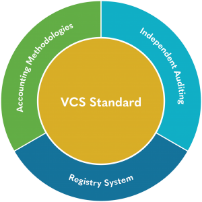Climate Change Services
CDM
About the CDM
There are currently more than 1890 registered CDM projects in 58 countries, and about another 2300 projects in the project validation/registration pipeline. Based on estimates in submitted project design documents, the CDM could generate more than 2.9 billion certified emission reductions by the end of the first commitment period of the Kyoto Protocol in 2012, each equivalent to one tonne of carbon dioxide.
Clean Development Mechanism
The CDM allows emission-reduction (or emission removal) projects in developing countries to earn certified emission reduction (CER) credits, each equivalent to one tonne of CO2. These CERs can be traded and sold, and used by industrialized countries to meet a part of their emission reduction targets under the Kyoto Protocol.
The mechanism stimulates sustainable development and emission reductions, while giving industrialized countries some flexibility in how they meet their emission reduction limitation targets.
The projects must qualify through a rigorous and public registration and issuance process designed to ensure real, measurable and verifiable emission reductions that are additional to what would have occurred without the project. The mechanism is overseen by the CDM Executive Board answerable ultimately to the countries that have ratified the Kyoto Protocol.
- In order to be considered for registration, a project must first be approved by the Designated National Authority
GS Audits
Gold Standard for the Global Goals is a standard that sets requirements to design projects for maximum positive impact in climate and development -- and to measure and report outcomes in the most credible and efficient way.

Gold Standard for the Global Goals customises safeguards, requirements, and methodologies to measure and verify impact on a wide range of activities -- from climate protection projects seeking to issue carbon credits to corporate supply chain interventions to national or subnational programmes looking for the most credible claims for their impact reporting.
VCS Audits
The VCS Program is the world’s most widely used voluntary GHG program. Almost 1,600 certified VCS projects have collectively reduced or removed more than 450 million tonnes of carbon and other GHG emissions from the atmosphere.
Individuals and corporations around the world are recognizing the importance of reducing their GHG emissions. As a result, many of them are reducing their carbon footprints through energy efficiency and other measures. Quite often, however, it is not possible for these entities to meet their targets or eliminate their carbon footprint, at least in the near term, with internal reductions alone, and they need a flexible mechanism to achieve these aspirational goals. Enter the carbon markets.
By using the carbon markets, entities can neutralize, or offset, their emissions by retiring carbon credits generated by projectsthat are reducing GHG emissions elsewhere. Of course, it is critical to ensure, or verify, that the emission reductions generated by these projects are actually occurring. This is the work of the VCS Program – to ensure the credibility of emission reduction projects.
Once projects have been certified against the VCS Program’s rigorous set of rules and requirements, project developers can be issued tradable GHG credits that we call Verified Carbon Units (VCUs). Those VCUs can then be sold on the open market and retired by individuals and companies as a means to offset their own emissions. Over time, this flexibility channels financing to clean, innovative businesses and technologies.
Verra’s role is to develop and administer the program. We provide oversight to all operational components of the VCS Program and we are responsible for updating the VCS rules such that they ensure the quality of VCUs. The development of the VCS Program is supported by the VCS Program Advisory Group, a multi-stakeholder body that helps ensure that the VCS Program continues to serve its users in an effective and efficient manner and drives practical and robust solutions to mitigate climate change.
How It Works
Projects developed under the VCS Program must follow a rigorous assessment process in order to be certified. VCS projects cover a diverse range of sectors, including renewable energy (such as wind and hydroelectric projects), forestry (including the avoidance of deforestation), and others. Emission reductions certified by our program are eligible to be issued as VCUs, with one VCU representing one metric tonne of greenhouse gas emissions reduced or removed from the atmosphere.

VCS Standard
The VCS Standard lays out the rules and requirements which all projects must follow in order to be certified.
Independent Auditing
All VCS projects are subject to desk and field audits by both qualified independent third parties and Verra staff to ensure that standards are met and methodologies are properly applied.
Accounting Methodologies
Projects are assessed using a technically sound GHG emission reduction quantification methodology specific to that project type.
Registry System
The registry system is the central storehouse of data on all registered projects, and tracks the generation, retirement and cancellation of all VCUs. To register with the program, projects must show that they have met all standards and methodological requirements.
While VCS projects typically include a discrete set of activities, governments are now establishing policies and programs to mitigate GHG emissions across entire national or subnational jurisdictions. In the forest sector, these programs (called REDD+ programs) can be accounted for and credited using the world’s first jurisdictional-scale framework, the Verra Jurisdictional and Nested REDD+ (JNR) framework. JNR integrates government-led and project-level REDD+ activities and establishes a clear pathway for subnational- and project-level activities to be incorporated within broader REDD+ programs.
The CCB Program
The Climate, Community & Biodiversity (CCB) Standards identify projects that simultaneously address climate change, support local communities and smallholders, and conserve biodiversity.
Sustainable development in all parts of the world involves land management. When carefully designed, land management projects can improve livelihoods, create employment, protect traditional cultures and endangered species, help secure tenure to lands and resources, increase the resiliency of ecosystems and help to combat climate change. The CCB Standards can be applied to any land management project, including projects under the VCS Program, to certify such climate, community, and biodiversity benefits.
Social Carbon Audits
SOCIALCARBON is a Standard developed by the Ecologica Institute that certifies carbon reduction projects for their contributions to sustainable development.
Six aspects of project sustainability are individually measured using the SOCIALCARBON hexagon: carbon and biodiversity as well as social, financial, human and natural components.
AA1000 Audits
AA1000 Assurance Standard (AA1000AS) 2008
The AA1000 AccountAbility Assurance Standard (2008) (currently in revision for launch in 2020) is the leading methodology used by sustainability professionals worldwide for sustainability-related assurance engagements, to evaluate the nature and extent to which an organization adheres to the AccountAbility Principles.

